| If you want to provide an easy way for people to download files from your iDisk's Public folder, you're in luck: HomePage includes a few file-download templates. To create a file-download page 1. | Upload the files you want to share to your iDisk's Public folder.
| 2. | Using a Web browser, go to www.mac.com and log in to your .Mac account.
The main .Mac members' page loads.
| 3. | Click the HomePage link.
The main HomePage page loads.
| 4. | On the lower left side of the page, click the File Sharing tab.
The File Sharing templates load (Figure 4.40). There are two types of templates here: My Downloads templates and iDisk Public Folder templates. The My Downloads templates allow you to choose any file on your iDisk; the iDisk Public Folder templates only list files in your iDisk's Public folder.
Figure 4.40. To begin creating a file-download page, click the File Sharing template that you want to use. 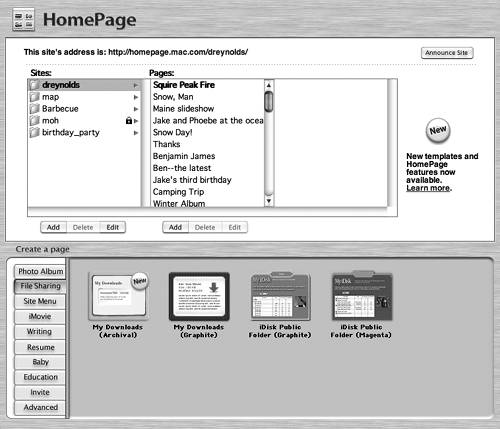
| 5. | Click the File Sharing template that you want to use.
The "Edit your page" page loads for the selected template. What you do next depends on whether you chose a My Downloads template or an iDisk Public Folder template.
| 6. | If you chose a My Downloads template, do the following (Figure 4.41):
- In the field at the top of the page, type a name for your Web page, which will serve as the page's link and appear at the top of your central .Mac homepage.
- Type a few sentences that describe your page. This text will appear below the page's title at the top of your Web page.
- In the Document Title field, type a title for the file that you're making available as a download.
- If you want the file's size to be displayed on the page, check the Show box to the right of the word "Size."
- In the description field, write a brief description of the file.
- To choose an image for the downloadable file's thumbnail from your iDisk, click the Choose button.
- To choose a file to use as a download from your iDisk's Movies, Pictures, Public, Sites, or Music folder, click the "Choose file" button.
Figure 4.41. If you've chosen a My Downloads template, enter a page title and a brief description, choose an image, and choose a file to be downloaded. 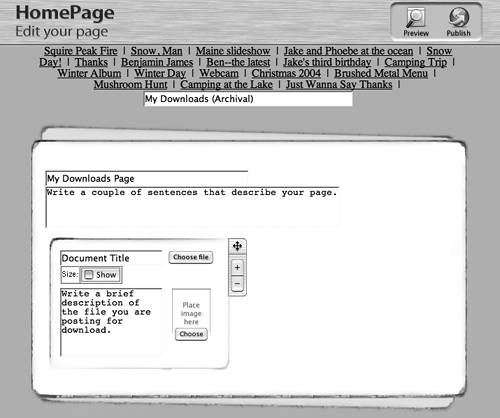
| 7. | If you chose an iDisk Public Folder template, do the following (Figure 4.42):
- In the field at the top of the page, type a name for your Web page, which will serve as the page's link and appear at the top of your central .Mac homepage.
- In the description field, type a description of the contents of your folder.
Figure 4.42. If you've chosen an iDisk Public Folder template, enter a page title and a brief description for your page. 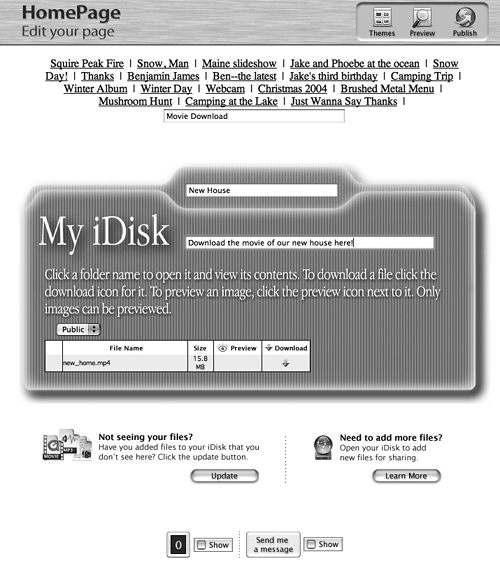
| 8. | If you want a hit counter, check the Show box to the right of the number 0 at the bottom of the page.
| 9. | If you want to include a "Send me a message" button (which viewers can use to send you an e-mail message), check the Show box to the right of the "Send me a message" button.
| 10. | To see what the page will look like before you publish it, click Preview.
A preview of the page loads (Figure 4.43).
Figure 4.43. After you click the Preview button, the page loads as others would see it giving you the opportunity to make any needed last-minute changes. 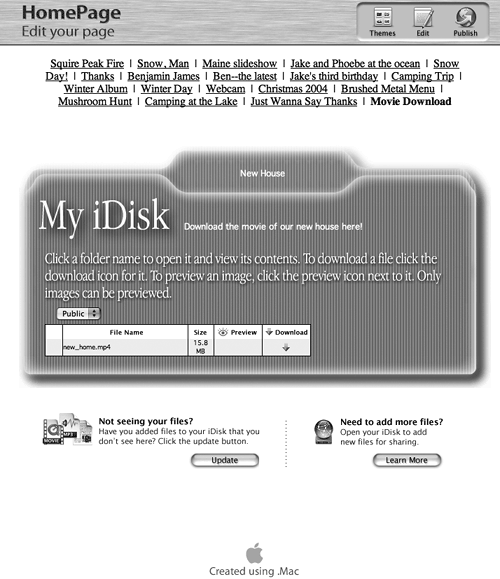
| 11. | If you need to make changes, click Edit. If you're satisfied with how it looks, click Publish.
A Congratulations page loads, displaying the download page's URL and giving you the opportunity to send an iCard announcing the new page (Figure 4.44).
Figure 4.44. When you've published your File Sharing page, you're given the page's URL and the opportunity to send an iCard announcing it. 
|
 Tips Tips
If files that you know are in your Public folder aren't appearing in the list, click the Refresh button to see if you can make them appear. To make sure that everyone can work with your files regardless of their operating system use care when naming your files. Stick to uppercase letters, lowercase letters, numbers, hyphens, and underscore characters only (this means no spaces), and you ought to be fine. And don't delete the filename extensions (such as .jpg or .doc). You can specify files from other folders on your iDisk with a My Downloads template, so it's not necessary for you to upload files strictly to the Public folder. You can add additional files to the download page by clicking the Plus (+) button to the right of the file-description area if you're using a My Downloads template. If you have multiple file-description areas on a download page, you can drag them around by the crossed vertical and horizontal arrow tab to rearrange them. You can remove a file from the download page if you're using a My Downloads template by clicking the minus sign to the right of its description area.
Say It with an iCard After you create a new .Mac Web page, the first thing you'll want to do is to tell people about it. Thanks to iCards, that's a breeze. When you finish creating a new site, a page opens asking if you want to send an iCard announcement. Click the arrow button in the bottom of the page and you're taken to a special iCard template page, where crafting a quick card with your URL is as easy as filling in the blanks (Figure 4.45). Figure 4.45. To send an iCard announcing your new page, simply choose a template, type a message, and add e-mail addresses to which you'll be sending it. When finished, click Send iCard. 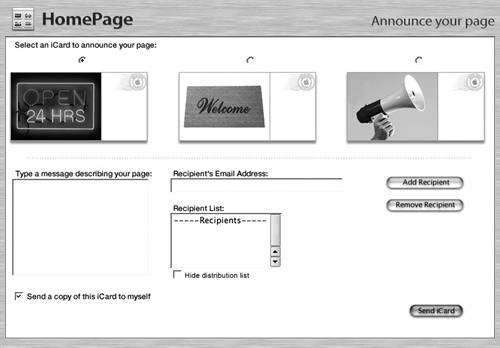
|
|





 Tips
Tips